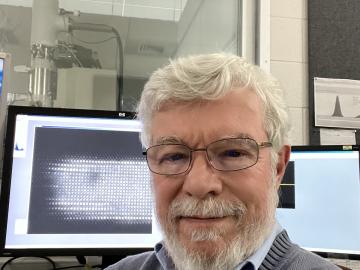
Filter News
Area of Research
- (-) Building Technologies (1)
- (-) Electricity and Smart Grid (1)
- (-) Materials (76)
- (-) Supercomputing (110)
- Advanced Manufacturing (3)
- Biology and Environment (38)
- Computational Biology (1)
- Computational Engineering (3)
- Computer Science (15)
- Energy Science (47)
- Functional Materials for Energy (1)
- Fusion and Fission (5)
- Fusion Energy (2)
- Isotope Development and Production (1)
- Isotopes (27)
- Materials for Computing (12)
- Mathematics (1)
- National Security (38)
- Neutron Science (26)
- Nuclear Science and Technology (13)
- Quantum information Science (8)
News Topics
- (-) Computer Science (100)
- (-) Cybersecurity (8)
- (-) Isotopes (14)
- (-) Machine Learning (15)
- (-) Microscopy (29)
- (-) Physics (34)
- (-) Space Exploration (5)
- 3-D Printing/Advanced Manufacturing (27)
- Advanced Reactors (5)
- Artificial Intelligence (39)
- Big Data (22)
- Bioenergy (18)
- Biology (14)
- Biomedical (22)
- Biotechnology (2)
- Buildings (11)
- Chemical Sciences (32)
- Clean Water (3)
- Composites (9)
- Coronavirus (17)
- Critical Materials (15)
- Energy Storage (37)
- Environment (35)
- Exascale Computing (26)
- Frontier (32)
- Fusion (8)
- Grid (11)
- High-Performance Computing (45)
- Irradiation (1)
- ITER (1)
- Materials (79)
- Materials Science (83)
- Mathematics (2)
- Microelectronics (1)
- Molten Salt (3)
- Nanotechnology (42)
- National Security (8)
- Neutron Science (42)
- Nuclear Energy (20)
- Partnerships (11)
- Polymers (18)
- Quantum Computing (21)
- Quantum Science (33)
- Security (7)
- Simulation (16)
- Software (1)
- Summit (43)
- Transportation (19)
Media Contacts

A multi-lab research team led by ORNL's Paul Kent is developing a computer application called QMCPACK to enable precise and reliable predictions of the fundamental properties of materials critical in energy research.

Researchers at the Department of Energy’s Oak Ridge National Laboratory and their technologies have received seven 2022 R&D 100 Awards, plus special recognition for a battery-related green technology product.

Larry Allard, a distinguished research staff member at Oak Ridge National Laboratory, has been named a Fellow of the Microanalysis Society.

ORNL Corporate Fellow and Center for Nanophase Materials Sciences researcher Bobby Sumpter has been named fellow of two scientific professional societies: the Institute of Physics and the International Association of Advanced Materials.

To solve a long-standing puzzle about how long a neutron can “live” outside an atomic nucleus, physicists entertained a wild but testable theory positing the existence of a right-handed version of our left-handed universe.

To optimize biomaterials for reliable, cost-effective paper production, building construction, and biofuel development, researchers often study the structure of plant cells using techniques such as freezing plant samples or placing them in a vacuum.

Two decades in the making, a new flagship facility for nuclear physics opened on May 2, and scientists from the Department of Energy’s Oak Ridge National Laboratory have a hand in 10 of its first 34 experiments.

The Frontier supercomputer at the Department of Energy’s Oak Ridge National Laboratory earned the top ranking today as the world’s fastest on the 59th TOP500 list, with 1.1 exaflops of performance. The system is the first to achieve an unprecedented level of computing performance known as exascale, a threshold of a quintillion calculations per second.

Researchers at ORNL are teaching microscopes to drive discoveries with an intuitive algorithm, developed at the lab’s Center for Nanophase Materials Sciences, that could guide breakthroughs in new materials for energy technologies, sensing and computing.

A team of researchers has developed a novel, machine learning–based technique to explore and identify relationships among medical concepts using electronic health record data across multiple healthcare providers.


